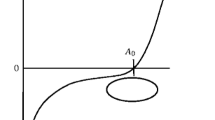Abstract
At various locations in the arterial system, plaques, or small relatively isolated protuberances, can develop on the inner wall of the vessel and project into the lumen. A number of investigators have suggested that the development and growth of these protuberances is related to the flow in the vicinity of the protuberance. In this study, the conditions under which the flow separates from an isolated protuberance located in a cylindrical tube were investigated. The critical Reynolds number at which separation first takes place for a given protuberance was determined. A series of tests was performed for steady flow of a Newtonian fluid through a rigid tube in which protuberances of various sizes were inserted. The results of the tests show the effect of the protuberance height and shape on the separation characteristics. In general, the results indicate that separation takes place at relatively small values of the Reynolds number; values that commonly occur in the arterial system, so that this phenomenon may be important in the study of the “coupling” between blood flow and arterial lesions.
Similar content being viewed by others
References
Fox, J. A., andHugo, A. E., “Localization of Atheroma: A Theory Based on Boundary Layer Separation,”Brit. Heart Jnl.,28,388 (1966).
Rodbard, S., “Dynamics of Blood Flow in Stenotic Lesions,”Am. Heart Jnl.,72,698 (1966).
Sako, Y., “Effects of Turbulent Blood Flow and Hypertension on Experimental Atherosclerosis,”Jnl. Am. Med. Assoc.,179,36 (1962).
Scharfstein, H., Gutstein, W. H., andLewis, L., “Changes of Boundary Layer Flow in Model Systems: Implications for Initiation of Endothelial Injury,”Circulation Res.,13,580 (1963).
Schneck, D. J., and Gutstein, W. H., “Boundary-Layer Studies in Blood Flow,” ASME Paper No. 66-WA/BHF-4.
Stephenson, S. E., Jr., Mann, G. V., Younker, R., andScott, H. W. Jr., “Factors Influencing the Segmental Deposition of Atheromatous Material,”Archives of Surgery,84 49 (1962).
Texon, M., “A Hemodynamic Concept of Atherosclerosis, with Particular Reference to Coronary Occlusion,”Archives of Internal Medicine,99,418 (1957).
Texon, M., “The Hemodynamic Concept of Atherosclerosis,”Bulletin New York Academy of Medicine,36,263 (1960).
Rodbard, S., “Physical Factors in the Progression of Vascular Lesions,”Circulation,17,410 (1958).
Young, D. F., “Effect of a Time-Dependent Stenosis on Flow Through a Tube,”Jnl. Engr. for Ind., Trans. ASME,90,248 (1968).
McDonald, D. A., “Blood Flow in Arteries,”Williams and Wilkins Co., Baltimore, Md., 18 (1960).
Author information
Authors and Affiliations
Rights and permissions
About this article
Cite this article
Young, D.F., Shih, C.C. Some experiments on the effect of isolated protuberances on flow through tubes. Experimental Mechanics 9, 225–229 (1969). https://doi.org/10.1007/BF02326540
Issue Date:
DOI: https://doi.org/10.1007/BF02326540




